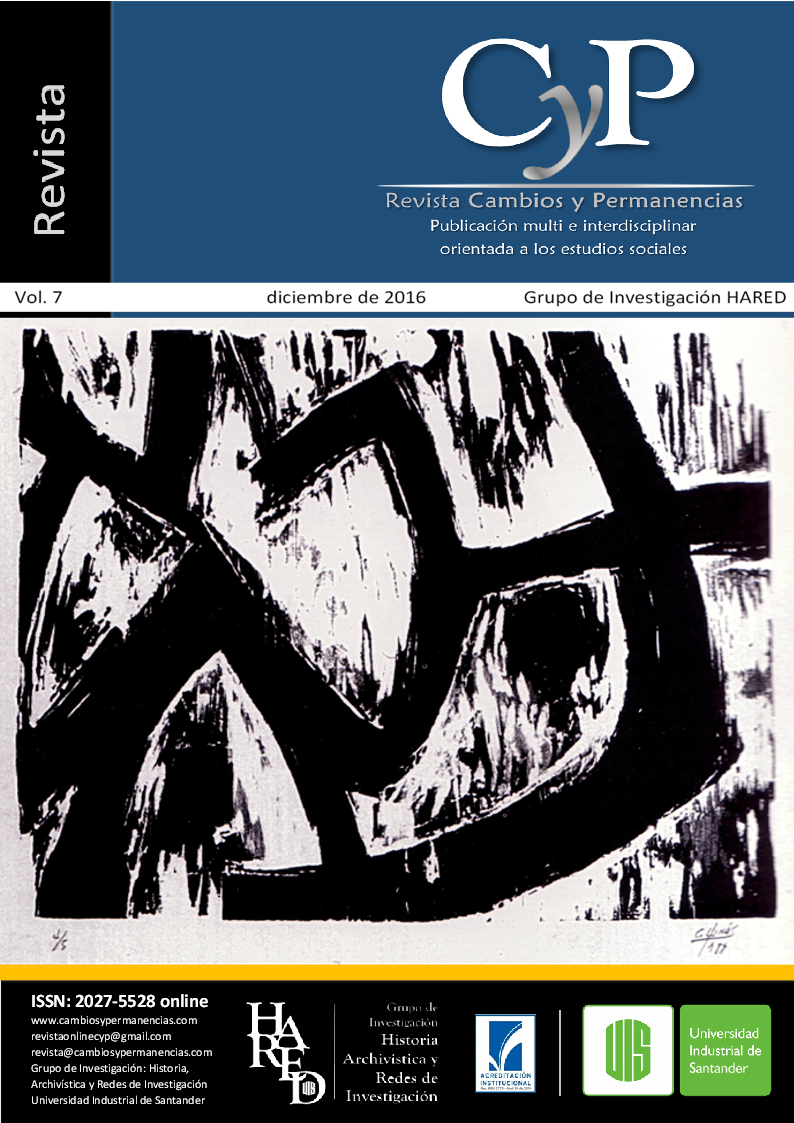DOSSIER PARA LA MEMORIA: EXCLUIDOS, COMUNIDADES Y POSCONFLICTO. SOBRE LA
Street people ¿ citizens subject to rights? This is a review of the national public policy for street people in the city of Bucaramanga
Keywords
- Street people,
- public policy,
- vulnerable population,
- human rights
How to Cite
Bernal, M., & Londoño Barbosa, V. (2016). Street people ¿ citizens subject to rights? This is a review of the national public policy for street people in the city of Bucaramanga. Cambios Y Permanencias, (7), 757–770. Retrieved from https://revistas.uis.edu.co/index.php/revistacyp/article/view/7072
Abstract
This research begins by doing a review about the state of art of population on the streets, with the purpose to analyze the public policy’s application established trough the law 1641 in 2013, inside the executed actions of the development plans during the government periods between 2007 to 2016 in Bucaramanga, Santander. Likewise, it will deploy the law’s correlation regarding to the fundamental rights established by the Colombian political constitution in 1991 and contrast of the lineaments that rest in the paper versus a reality, that this community is living.
Downloads
Download data is not yet available.
References
Bohórquez, L. (2012). Plan de Desarrollo 2012-2015. Bucaramanga, Colombia: Alcaldía de Bucaramanga.
Centro Internacional de Teo-terapia Integral CENTI. (s.f.). ¿Qué es la Teo terapia? Recuperado de: http://navesalvavidas.weebly.com/la-teoterapia.html
Cepeda Bolívar, J. y Torres Gómez, F. (2012). Prácticas y saberes en torno a la alimentación de los ciudadanos habitantes de calle en la localidad Mártires. Revista Perspectivas, 23, 61-77.
Corte Constitucional de la República de Colombia. (1992). Sentencia No. T426/92. Recuperado de: http://www.corteconstitucional.gov.co/relatoria/1992/T426-92.htm
El Espectador. (2012). Estado, obligado a rehabilitar habitantes de la calle. Recuperado de: http://www.elespectador.com/noticias/politica/estado-obligadorehabilitar-habitantes-de-calle-articulo-354269
El Espectador. (2015). Corte Constitucional pide a Minsalud una política parahabitantes de calle. Recuperado de: http://www.elespectador.com/noticias/judicial/corte-constitucional-pideminsalud-una-politica-habitan-articulo-549063
Hernández, R. (2016). Plan de Desarrollo 2016-2019. Bucaramanga, Colombia: Alcaldía de Bucaramanga.
Ley 1641 de 2013: Política pública social para Habitantes de la calle. Recuperado de: http://wsp.presidencia.gov.co/Normativa/Leyes/Documents/2013/LEY%20141%20DEL012 %20DE%20JULIO%20DE%202013.pdf
Moreno Galvis, H. (2011). Informe de Rendición de Cuentas – Vigencia 2011- . Bucaramanga, Colombia: Alcaldía de Bucaramanga.
Patiño Ballesteros, J. (22 de Septiembre de 2016). Entrevistada por Viviana Londoño. Estudiante de Semillero de Investigación de Derechos Humanos de la Universidad Pontificia Bolivariana de Bucaramanga. Programa “Habitante de Calle”. Secretaría de Desarrollo Social. Alcaldía de Bucaramanga. Rodríguez
Loaiza, M. (2011). Intervención de Trabajo Social en población habitante de calle consumidora de SPA en proceso de rehabilitación – Shalom “Casa de Paz”- . Universidad Industrial de Santander. Facultad de Ciencias Humanas. Escuela de Trabajo Social. Bucaramanga, Colombia.
República de Colombia (1991). Constitución Política de Colombia de 1991. Recuperado de: http://www.registraduria.gov.co/IMG/pdf/constitucio-politicacolombia-1991.pdf
Ruíz, J. (1999). Los citadinos de la calle, nómadas urbanos. Revista Nómadas. 10, 172-177.
Sarmiento Osma, E. (2011). Informe Gestión 2008-2011 Proceso de Empalme. Bucaramanga, Colombia: Secretaria de Desarrollo Social, Alcaldía de Bucaramanga.
Secretaria de Integración Social -SDIS- Sub-dirección de adultez. (2014). Foro Nacional/Distrital: Por la Dignidad Humana y la restitución de derechos de las y los ciudadanos habitantes de calle. Bogotá, D.C.
Tarazona Álvarez, Y. (2015). Informe de Gestión al Concejo Municipal – Segundo trimestre de 2015. Bucaramanga: Secretaria de Desarrollo Social. Alcaldía de Bucaramanga.
Vanguardia Liberal. (2015). Cerca de 1.147 habitantes de calle deambulan en Bucaramanga. Recuperado de http://www.vanguardia.com/areametropolitana/bucaramanga/314727-cerca-de-1147-habitantes-de-calledeambulan-en-bucaramanga
Vargas Mendoza, F. (2011). Plan de Desarrollo 2008-2011. Bucaramanga, Colombia: Alcaldía de Bucaramanga.
Centro Internacional de Teo-terapia Integral CENTI. (s.f.). ¿Qué es la Teo terapia? Recuperado de: http://navesalvavidas.weebly.com/la-teoterapia.html
Cepeda Bolívar, J. y Torres Gómez, F. (2012). Prácticas y saberes en torno a la alimentación de los ciudadanos habitantes de calle en la localidad Mártires. Revista Perspectivas, 23, 61-77.
Corte Constitucional de la República de Colombia. (1992). Sentencia No. T426/92. Recuperado de: http://www.corteconstitucional.gov.co/relatoria/1992/T426-92.htm
El Espectador. (2012). Estado, obligado a rehabilitar habitantes de la calle. Recuperado de: http://www.elespectador.com/noticias/politica/estado-obligadorehabilitar-habitantes-de-calle-articulo-354269
El Espectador. (2015). Corte Constitucional pide a Minsalud una política parahabitantes de calle. Recuperado de: http://www.elespectador.com/noticias/judicial/corte-constitucional-pideminsalud-una-politica-habitan-articulo-549063
Hernández, R. (2016). Plan de Desarrollo 2016-2019. Bucaramanga, Colombia: Alcaldía de Bucaramanga.
Ley 1641 de 2013: Política pública social para Habitantes de la calle. Recuperado de: http://wsp.presidencia.gov.co/Normativa/Leyes/Documents/2013/LEY%20141%20DEL012 %20DE%20JULIO%20DE%202013.pdf
Moreno Galvis, H. (2011). Informe de Rendición de Cuentas – Vigencia 2011- . Bucaramanga, Colombia: Alcaldía de Bucaramanga.
Patiño Ballesteros, J. (22 de Septiembre de 2016). Entrevistada por Viviana Londoño. Estudiante de Semillero de Investigación de Derechos Humanos de la Universidad Pontificia Bolivariana de Bucaramanga. Programa “Habitante de Calle”. Secretaría de Desarrollo Social. Alcaldía de Bucaramanga. Rodríguez
Loaiza, M. (2011). Intervención de Trabajo Social en población habitante de calle consumidora de SPA en proceso de rehabilitación – Shalom “Casa de Paz”- . Universidad Industrial de Santander. Facultad de Ciencias Humanas. Escuela de Trabajo Social. Bucaramanga, Colombia.
República de Colombia (1991). Constitución Política de Colombia de 1991. Recuperado de: http://www.registraduria.gov.co/IMG/pdf/constitucio-politicacolombia-1991.pdf
Ruíz, J. (1999). Los citadinos de la calle, nómadas urbanos. Revista Nómadas. 10, 172-177.
Sarmiento Osma, E. (2011). Informe Gestión 2008-2011 Proceso de Empalme. Bucaramanga, Colombia: Secretaria de Desarrollo Social, Alcaldía de Bucaramanga.
Secretaria de Integración Social -SDIS- Sub-dirección de adultez. (2014). Foro Nacional/Distrital: Por la Dignidad Humana y la restitución de derechos de las y los ciudadanos habitantes de calle. Bogotá, D.C.
Tarazona Álvarez, Y. (2015). Informe de Gestión al Concejo Municipal – Segundo trimestre de 2015. Bucaramanga: Secretaria de Desarrollo Social. Alcaldía de Bucaramanga.
Vanguardia Liberal. (2015). Cerca de 1.147 habitantes de calle deambulan en Bucaramanga. Recuperado de http://www.vanguardia.com/areametropolitana/bucaramanga/314727-cerca-de-1147-habitantes-de-calledeambulan-en-bucaramanga
Vargas Mendoza, F. (2011). Plan de Desarrollo 2008-2011. Bucaramanga, Colombia: Alcaldía de Bucaramanga.

